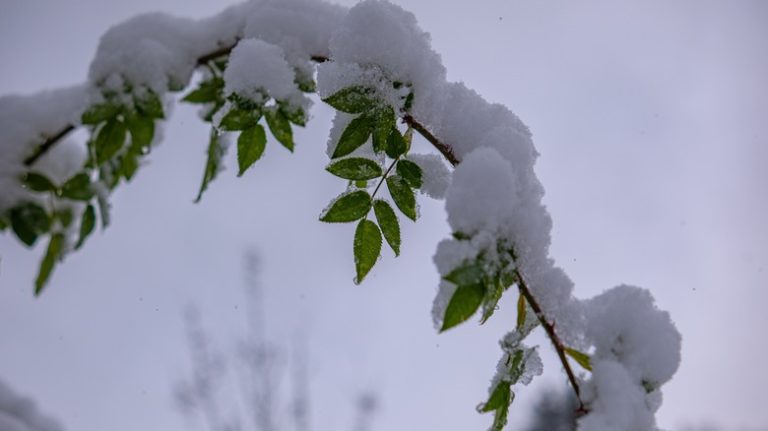Earlier this week, food came front and center at a special dinner held in honor of five years of research led by the Soil Science Program. The event at the horticulture center began with a talk by Rachel Johnson, who is a horticulture professor and head of the Soil Science Program. She spoke about the important role that soils play in our everyday lives and how much we depend on them for growing food, building homes, and restoring nature.
One of the highlights of the evening was a menu created by Chef Stella Harris that featured dishes made from ingredients grown in the fertile soils of the horticulture center. The five-course meal began with an appetizer of subhirtella cherry blossom tempura, followed by a salad made with fresh shirofugen cherry blossoms. The main course was a flavorful yoshino cherry-glazed salmon, and for dessert, guests enjoyed a delicate yoshino cherry mousse.
During the dinner, there was also a discussion about the different types of cherry blossoms that can be found in the area. Dr. Thomas Hardy, a cherry blossom expert, talked about the most popular varieties including the ‘Stella’, ‘Go’, ‘Autumnalis’, and ‘Sargent’ cherry trees. He explained how these trees differ in their growth habits, bloom times, and taste.
Dr. Hardy also mentioned the importance of proper care and pruning to ensure that cherry trees stay healthy and beautiful. He recommended using a balanced fertilizer, such as the ‘Shirofugen’, and providing adequate water throughout the growing season. Dr. Hardy advised against over-pruning, as it can weaken the tree and make it more susceptible to diseases.
To end the evening, guests were invited to take a stroll through the horticulture center’s cherry blossom garden, where they could admire the stunning beauty of the blooming ‘Yoshino’ and ‘Okame’ cherry trees. As the soft pink and white blossoms fluttered in the breeze, a sense of peace and tranquility filled the air.
“Cherry blossoms are one of nature’s superstars,” said Dr. Hardy. “They not only beautify our landscapes, but they also bring joy, renewal, and a sense of connection to the world around us.”
As the evening drew to a close, guests left with a newfound appreciation for the beauty and ecological importance of cherry blossoms. The dinner had provided not only a delicious meal but also an opportunity to learn and connect with others who share a love for these showy spring flowers.
Cherry Tree Care – How To Grow Cherry Trees
Cherry trees are a symbol of beauty and grace, and growing them can be a rewarding experience. With the right care and attention, these trees can thrive and produce delicious cherries for many years to come.
There are different types of cherry trees to choose from, each with its own unique characteristics. Some popular varieties include the Okame and the Subhirtella, which bloom early in the spring. The Yoshino cherry trees, also known as Somei-Yoshino, are particularly popular in Japan and are often associated with the famous Cherry Blossom Festival. The Shirofugen cherry tree, on the other hand, blooms later in the spring and has beautiful pink flowers with serrated edges.
When planting cherry trees, it is important to choose a suitable location. Cherry trees thrive in well-draining soil that retains moisture but does not get waterlogged. They require full sun and should be planted away from large trees or buildings that can create too much shade.
To plant a cherry tree, dig a hole that is twice as wide and as deep as the tree’s root ball. Place the tree in the hole, making sure that the bud union is above ground level. Fill the hole with soil and water thoroughly. Cherry trees should be watered regularly, particularly during hot and dry periods. Applying a balanced fertilizer in early spring and again in early summer can also help promote healthy growth.
Cherry trees are relatively low-maintenance but do require some care to stay healthy. Pruning should be done in late winter or early spring, and dead or diseased branches should be removed. Regularly inspect the tree for pests and diseases, and treat as necessary. In colder regions, it is important to protect cherry trees from harsh winter conditions.
Cherry trees are not only beautiful but also provide a bountiful harvest of delicious cherries. Whether you choose to grow them for their striking blossoms or their flavorful fruit, cherry trees are sure to be a wonderful addition to your garden.
| Popular Cherry Tree Varieties | Bloom Time |
|---|---|
| Okame | Early spring |
| Subhirtella | Early spring |
| Somei-Yoshino | Early to mid-spring |
| Shirofugen | Mid-spring |
Whether you go for the early bloomers like Okame and Subhirtella or the later bloomers like Somei-Yoshino and Shirofugen, cherry trees are a beautiful addition to any landscape. So why not plant one today and enjoy the beauty and benefits they bring?
Quick Facts about Cherry Trees
Cherry trees, also known as Prunus avium and Prunus cerasus, are popular trees that grow in many parts of America. They belong to the dogwood family and depend on well-drained soils to thrive. There are several varieties of cherry trees, including the Higan cherry, Somei-Yoshino, Kwanzan, Montmorency, Sargent cherry, and Stella cherry.
Cherry trees are rather small, growing up to 15+ feet in height. They have showy flowers that come in white, pink, or darker colors, depending on the cultivars. In spring, the cherry trees become crowned with beautiful blossoms, creating a stunning sight. Some cherry tree varieties have double or weeping flowers, which adds to their appeal.
The cherry trees are known for their tart and sweet cherries that are used for various purposes. Cherry pies, preserves, and juices are just some examples of the delicious treats that can be made with cherries. The cherries can be enjoyed fresh or used in cooking and baking.
When planting cherry trees, it is important to choose a location with well-drained and fertile soil. The hole for the tree should be wide and deep enough to accommodate the roots. Cherry trees require regular watering, especially during the first year. They also benefit from regular fertilizer applications to ensure healthy growth.
Cherry trees are deciduous, meaning they shed their leaves in the fall. The leaves of cherry trees are typically green and turn yellow, orange, or red in the autumn. The bare branches of the cherry tree create a beautiful silhouette against the winter sky.
Cherry trees are known for their relatively short blooming period, usually lasting a few weeks. However, the beauty of their blossoms makes up for the short timeframe. Many people travel to areas such as Washington, D.C., and New York to witness the stunning cherry blossom show.
In Japan, cherry trees hold a special significance and are celebrated during the cherry blossom festival called Hanami. The Yoshino cherry, or Somei-Yoshino, is one of the most popular cherry tree varieties in Japan. It has white flowers that create a picturesque scene when in full bloom.
Cherry trees have been cultivated since ancient times and have been introduced to different parts of the world. The famous guitarist Jimi Hendrix even has a cherry tree named after him in the village of Egendorf, Austria. The Hendrix cherry tree is a “weeping” variety with beautiful pink blossoms.
In addition to their visual beauty, cherry trees provide ecological benefits. They attract pollinators such as bees and butterflies, which help with the reproduction of other plants. Cherry trees also provide shade and cool the surrounding environment.
Whether you plant a cherry tree for its beauty, delicious fruit, or ecological benefits, it is sure to enhance any landscape. With proper care and attention, cherry trees can be a long-lasting and rewarding addition to your garden.
Cherry Tree Care
Cherry trees are a gift of nature, and caring for them during all seasons is essential to ensure their health and longevity. There are several types of cherry trees, each with its own unique characteristics and requirements. One popular type is the weeping cherry tree (Prunus pendula), which is rather a showy variety and is often placed in prominent locations in gardens.
When planting a cherry tree, it is important to choose a suitable site with well-draining soil and ample sunlight, particularly in the southern regions. Dig a hole that is two to three times wider than the root ball and slightly shallower than the depth of the container. Gently place the tree in the hole and backfill with soil, firming it gently to eliminate any air pockets.
Pruning is an important part of cherry tree care and should be done during the dormant period, which is typically in winter. Remove any dead, diseased, or damaged branches to promote new growth and improve the overall health and shape of the tree. However, avoid excessive pruning, as this can weaken the tree and make it more susceptible to diseases and pests.
Fertilizing cherry trees is also crucial for their health and productivity. Apply a balanced fertilizer in early spring, following the manufacturer’s instructions. In addition, it is beneficial to apply a layer of organic mulch around the base of the tree to retain moisture, suppress weeds, and provide nutrients as it decomposes.
Cherry trees can encounter a few problems, such as pests and diseases. Common pests include aphids, spider mites, and scale insects, which can be controlled with appropriate insecticides or horticultural oils. Diseases like cherry leaf spot and powdery mildew can be prevented or treated with fungicides. Regular inspections and timely interventions can help keep the tree healthy.
There are many different types of cherry trees, each with its own beauty and taste. Some popular varieties include Yoshino (Prunus x yedoensis), which is known for its graceful form and fragrant white flowers, and Akebono (Prunus x subhirtella ‘Akebono’), which produces stunning pink blossoms. Another popular type is the Kwanzan cherry tree (Prunus serrulata ‘Kanzan’), which has double pink flowers and serrated leaves.
Cherry trees play a significant role in parks and gardens, particularly during the cherry blossom season. In Japan, cherry blossoms symbolize the fleeting beauty of life and have been celebrated for centuries. In New York, the annual Cherry Blossom Festival in Brooklyn Botanic Garden attracts thousands of visitors who come to admire the beauty of the cherry trees in full bloom. The festival asks visitors to treat the trees with respect and not to pick the blossoms.
One unique type of cherry tree is the Kamala cherry (Prunus serrulata ‘Kamala’), introduced by the U.S. Army’s Superintendent of New York’s Central Park, Sara H. Chapman, in the late 1800s. It is a hybrid of the Yoshino cherry and produces fragrant, tulip-like flowers. The Kamala cherry tree is known for its upright form and large, showy blossoms.
Another popular type of cherry tree is the Autumn cherry (Prunus subhirtella ‘Autumnalis’), also known as the Winter Cherry. It is valued for its ability to bloom intermittently throughout the winter months. The Autumn cherry tree produces delicate pink or white flowers during periods of warmer weather, making it a standout in the winter landscape.
The Shirofugen cherry (Prunus serrulata ‘Shirofugen’) is a late-flowering variety that produces stunning double white flowers. It is often planted alongside other cherry tree varieties to extend the blooming period and provide a beautiful display of colors.
Cherry trees require a direct sunlight and a well-draining soil to thrive and produce abundant fruit. While some varieties, like the sour cherry (Prunus cerasus), are known for their tart taste and are used primarily for cooking and baking, others like the sweet cherry (Prunus avium) are enjoyed fresh. The taste of the fruit can also depend on the time of harvest, with some varieties becoming sweeter and juicier as they ripen.
Overall, cherry tree care is essential to ensure the health and beauty of these remarkable trees. Proper planting, pruning, fertilizing, and addressing any issues promptly will help the trees thrive and provide enjoyment for years to come.


